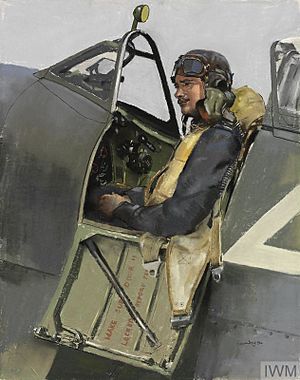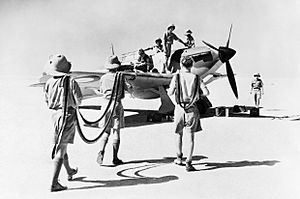James Hayter (RAF officer) facts for kids
Quick facts for kids
James Hayter
|
|
|---|---|

Portrait of James Hayter, sitting in the cockpit of a Supermarine Spitfire fighter, painted by William Dring in 1944
|
|
| Born | 18 October 1917 Timaru, New Zealand |
| Died | 3 October 2006 (aged 88) Takaka, New Zealand |
| Allegiance | New Zealand |
| Service/ |
Royal New Zealand Air Force Royal Air Force |
| Years of service | 1938–1939; 1944–1945 (RNZAF) 1939–1944 (RAF) |
| Rank | Squadron Leader |
| Commands held | No. 74 Squadron No. 274 Squadron |
| Battles/wars | Second World War |
| Awards | Distinguished Flying Cross & Bar Mention in despatches (2) |
James Chilton Francis Hayter (1917–2006) was a brave New Zealand flying ace. He flew for the Royal Air Force (RAF) during the Second World War. An "ace" is a pilot who shoots down five or more enemy aircraft. James Hayter was officially credited with at least five victories in the air.
Born in Timaru, New Zealand, Hayter joined the Royal New Zealand Air Force (RNZAF) in 1938. After his flight training, he went to the United Kingdom. In 1939, he joined the RAF. He flew Fairey Battle bombers during the Battle of France. Later, he became a fighter pilot. He flew Hawker Hurricanes in the famous Battle of Britain. He also fought on the Channel Front in 1941.
Hayter became an instructor for a while. Then he joined No. 601 Squadron. He received the Distinguished Flying Cross (DFC) for his bravery. In 1942, he went to the Middle East. There, he led No. 274 Squadron. He later commanded No. 74 Squadron in 1943. This squadron fought in the eastern Mediterranean Sea, including the Dodecanese campaign.
In 1944, his squadron returned to the UK. They supported the Allied forces in Europe. Hayter later transferred back to the RNZAF. He returned to New Zealand in 1945. After the war, he became a farmer and then a sailor. He passed away in 2006, at 88 years old.
Contents
Early Life and Flight Training
James Chilton Francis Hayter was born in Timaru, New Zealand, on 18 October 1917. His father was a farmer. James went to Nelson College for his education. After school, he worked on his father's farm on D'Urville Island. He also worked on other farms in the Marlborough region.
In his free time, James learned to fly at the Marlborough Aero Club. He decided he wanted to be a military pilot. So, in November 1938, he joined the Royal New Zealand Air Force (RNZAF). He started his training at Wigram. He earned his pilot's "wings" on 19 April 1939.
During his training, he had a couple of minor accidents. Once, the plane he was observing in had to land suddenly. Another time, the pilot flew too low, and the plane crashed. James had only minor injuries. After finishing his training in June, he left New Zealand. He sailed to the United Kingdom to join the Royal Air Force (RAF). He became a pilot officer in August 1939. He was first posted to No. 98 Squadron, which flew Fairey Battle bombers.
Fighting in the Second World War
Battle of France and Early Missions
In November 1939, Hayter joined No. 103 Squadron. This squadron was sent to France as part of the RAF's forces. They flew Fairey Battle bombers. Their main jobs were to fly over the French-German border to see what the enemy was doing. They also dropped leaflets over Germany.
On 10 May 1940, Germany invaded France. Two days later, Hayter flew his first bombing mission. He attacked a bridge over the Meuse River. Even though German fighters tried to stop him, he succeeded. Later, many bombers were lost in big raids. The slow Fairey Battles were not used as much after that. Hayter's squadron had to move bases often to avoid the advancing German army.
The bomber squadrons kept attacking German troops and transport. On 12 June, Hayter and his gunner fought a German reconnaissance plane. It seemed to crash, but Hayter didn't claim it. It was later confirmed as destroyed by French forces. On 16 June, Hayter's plane was shot down by a German Messerschmitt Bf 109 fighter. He was not hurt. His squadron was pulled back to England just hours before France surrendered. Hayter then decided to join Fighter Command. He became a flying officer on 3 September. He was sent to No. 605 Squadron.
Defending Britain: The Battle of Britain
No. 605 Squadron was based at Croydon. They flew Hawker Hurricane fighters. Their job was to stop German Luftwaffe raids on London. They regularly patrolled over Kent and Surrey. On 15 October, Hayter damaged a German Bf 109 fighter.
On 26 October, he damaged another Bf 109. But right after, his own plane was shot down. Hayter parachuted out of his damaged aircraft. He landed in the garden of a Member of Parliament. He was slightly hurt, but a doctor helped him. The Battle of Britain ended a few days later. In December, Hayter destroyed another Bf 109 while flying a new Hurricane.
Channel Front and Instructor Duties
In early 1941, Fighter Command started attacking German targets over France. No. 605 Squadron began escorting bombers. In February, Hayter became a flight commander. He was promoted to acting flight lieutenant. He had flown 150 missions by May. He was then sent to be an instructor at a training unit.
Being an instructor was still risky. In June, Hayter had two crashes in three days. This happened because his student pilot froze during landings. Later, Hayter joined No. 611 Squadron. They flew Supermarine Spitfire fighters. They often flew bomber escort missions and patrols over France. On 10 July, Hayter shot down a Bf 109. His Spitfire was damaged by anti-aircraft fire, and he had to crash-land. Four days later, he destroyed another Bf 109. On 29 August, he shot down a Bf 109 over England. In October, he was awarded the Distinguished Flying Cross (DFC) for his brave actions.
Fighting in the Middle East
In March 1942, Hayter was sent to the Middle East. He joined No. 33 Squadron in Libya. They flew Hurricanes. They patrolled the front lines and escorted bombers. In June, Hayter's Hurricane was damaged in a dogfight with an Italian Macchi MC.202. As he tried to crash-land, he managed to fire his guns at the Italian plane. The Italian pilot also had to crash-land and was captured.
The next month, Hayter was promoted to acting squadron leader. He became the commander of No. 274 Squadron. This squadron flew Hurricane fighter-bombers. They attacked ground targets and patrolled around El Alamein. On 18 July, Hayter shot down a Bf 109 over El Alamein.
In October, Hayter went to Turkey. He helped train Turkish pilots to fly Hurricanes and P-40 Kittyhawks. In March 1943, he took command of No. 74 Squadron in Iran. His squadron later moved to Egypt. On 23 July, Hayter led a large group of fighters to German-occupied Crete. His flight attacked ground targets and returned safely.
In September, No. 74 Squadron took part in the Dodecanese campaign. This was an attempt to take islands in the Aegean Sea. Hayter's squadron flew from Kos Island. On 3 October, the Germans invaded Kos and took the airfield. Hayter and other pilots left their planes and hid in the hills. They avoided the Germans for four days. Then, they were rescued by the Special Boat Service and taken to Cyprus. Hayter was later mentioned in official reports for his efforts to escape capture.
Return to Europe and End of War
In April 1944, No. 74 Squadron returned to the United Kingdom. They received new Spitfire Mk LF.IXe planes. They flew patrols, escorted bombers, and attacked targets. Hayter was again mentioned in official reports for his "distinguished service." His squadron also flew missions to stop German V-1 flying bombs. On 1 July, Hayter's rank of squadron leader became permanent.
Later in July, No. 74 Squadron joined the Second Tactical Air Force. They flew bomber escort missions. They moved to France in August. They often supported the Allied armies on the ground. By this time, Hayter transferred back to the RNZAF.
Hayter gave up command of No. 74 Squadron in December. He returned to the UK. In January 1945, he received a second award (a "bar") for his DFC. He took a course for fighter leaders. By June, he was preparing to return to New Zealand. He left the UK in August. By the end of the war, James Hayter had flown 535 missions. He was credited with shooting down five enemy aircraft. He also probably destroyed one and damaged three others.
Life After the War
James Hayter arrived back in New Zealand in September 1945. He left the RNZAF at the end of the year. In his civilian life, he became a farmer. However, his war injuries made farming difficult. After operations on his back, he sold his farm. He then became a mariner, working on ships. He worked on a survey ship in Australia, Singapore, and South America. He later earned a master's certificate, allowing him to command ships. He then worked in the shipping industry in the United States.
In 1973, he returned to New Zealand and farmed again. Four years later, he managed a camping ground. He later worked in property development in Takaka. James Hayter passed away on 3 October 2006, in Takaka. He is buried in Wakapuaka Cemetery in Nelson.



